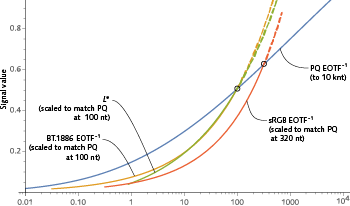
High dynamic range (HDR) technology enables a much wider range of luminances – both relative and absolute – than standard dynamic range (SDR). HDR extends black to lower levels, and white to higher levels, than SDR. HDR enables higher absolute luminance at the display to be used to portray specular highlights and direct light sources, a capability that was not available in SDR. In addition, HDR programming is mastered with wider color gamut, usually DCI P3, wider than the BT.1886 (“BT.709”) gamut of SDR. The capabilities of HDR strain the usual SDR methods of specifying color range. New methods are needed. A proposal has been made to use CIE LAB to quantify HDR gamut. We argue that CIE L* is only appropriate for applications having contrast range not exceeding 100:1, so CIELAB is not appropriate for HDR. In practice, L* cannot accurately represent lightness that significantly exceeds diffuse white – that is, L* cannot reasonably represent specular reflections and direct light sources. In brief: L* is inappropriate for HDR. We suggest using metrics based upon ST 2084/BT.2100 PQ and its associated color encoding, IC<sub>T</sub>C<sub>P</sub>.
Charles Poynton, "Luminance, Brightness, and Lightness Metrics for HDR" in Color and Imaging Conference, 2022, pp 24 - 29, https://doi.org/10.2352/CIC.2022.30.1.06
 Find this author on Google Scholar
Find this author on Google Scholar Find this author on PubMed
Find this author on PubMed